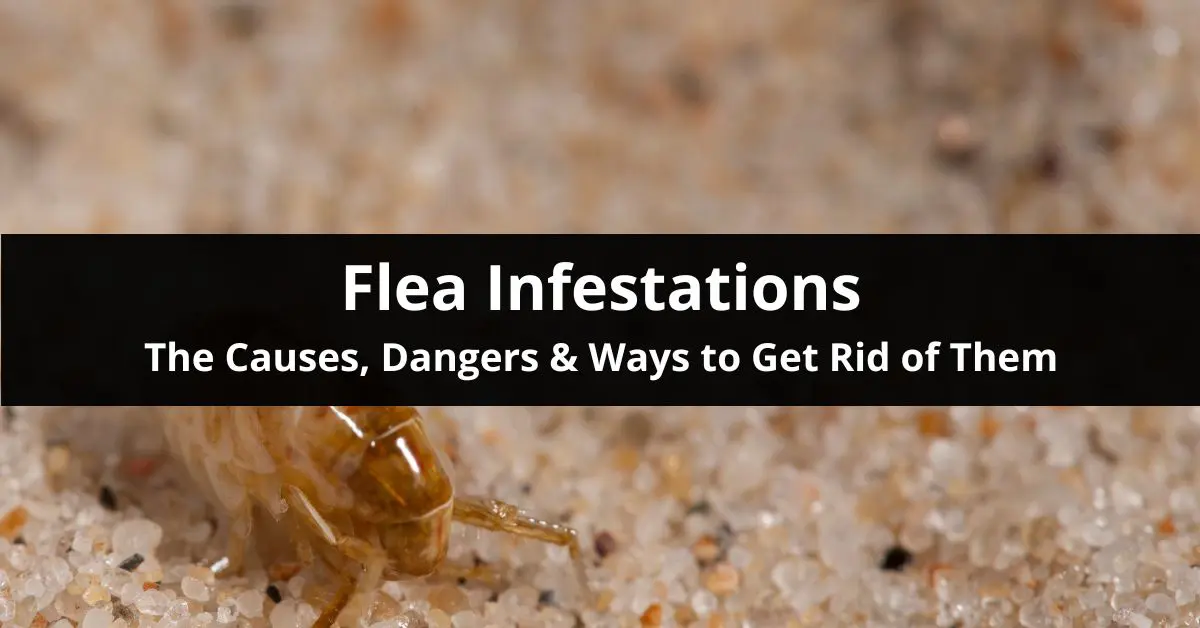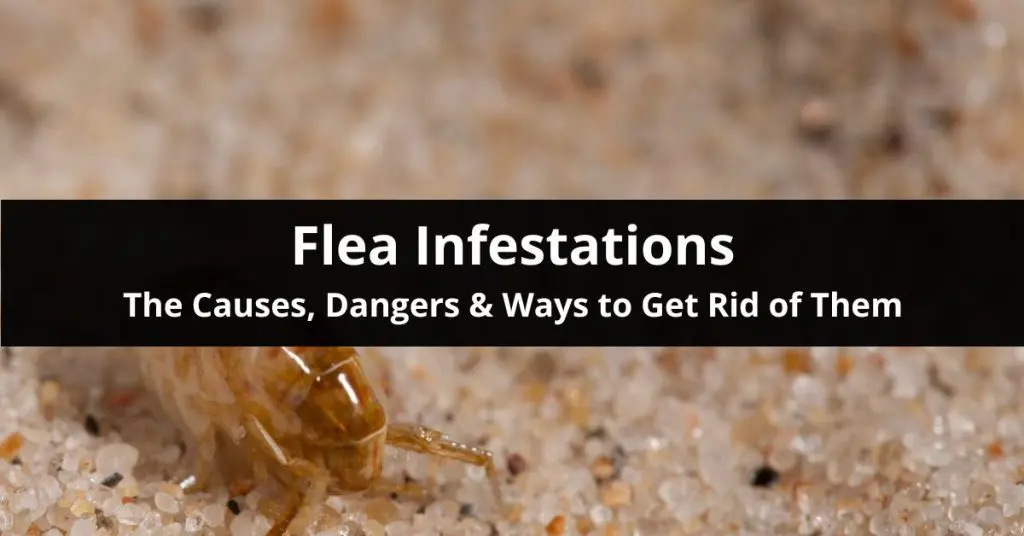Flea infestations happen, and to people without furbabies in their home. But as expected, the most common cause is when you’ve got a furry friend and they bring home an uninvited guest (or two….thousand) after playing in the yard. But how do they get into your yard and onto your furbaby?
Fleas make it to your yard by jumping off neighborhood feral cats and raccoons. From there they find shady spots and begin to multiply creating the infestation. The flea infestation in your yard will eventually find its way into your house via your furry friend or sometimes you.
And while almost every pet loves a good scratch, if you notice unusual movements or an increase in scratching, this may be a sign of the beginning of a flea infestation in your home. If it is, the flea infestation will spread and hide in your bedding, furniture, and floor cracks.
So how can you tell how bad a flea infestation is in your home?
You have a large flea infestation if:
- You can see multiple fleas are hopping between your furniture and the curtains
- There are red bumps on your lower body, especially your ankle, knee folds, legs, calves, and feet
- Your pet’s fur has multiple dot-like insects
- Your pet is scratching, licking, or biting their fur excessively
- You find blackish-red specks of pepper-like dust on your bed
- There are tiny whitish shells on your soft furnishings
Bonus tip: Do the white sock test. Put on a white socks and drag your feet around your home. Slowly walk across your floors, carpets, lay on your bed, couch, etc.. Now, use a flashlight and magnifying glass to look for visible fleas and flea eggs on your socks. If you have a large flea infestation, there will be fleas and/or eggs stuck to them.
A flea infestation happens very quickly too. A single female flea can lay 50 eggs in one day for 50 days! These eggs then hatch in 1-10 days and the blood-sucking critters become an adult that can breed in just 2-3 weeks. Even worse, adult fleas can live up to 100 days. Within a couple months, that’s 2500 fleas in your home just from 1 pregnant flea finding her way in!
Not-So-Fun-Fact: Flea larvae can remain dormant for months which is why flea infestations seem to reappear and make them difficult to treat.
No matter the size of your infestation, battling these pests requires persistence. Don’t worry though – you aren’t alone and you have options!
First and foremost, don’t wait to begin treating a flea infestation. Fleas spread parasites and diseases like typhus, bubonic plague, and cat scratch disease (CSD) as well as giving your pet heartworm and tapeworms. (Tapeworms can infect humans too.)
Here is how to get rid of flea infestations in your home, then your yard including both natural and chemical solutions.
Ways to Get Rid of Fleas Within Your Home
Clear your house of these pests by using some of the following tips and tricks.
Treat your carpets and floors.
Vacuum
Regular vacuuming will lower the number of fleas and their eggs you have in your carpeting, cracks in your wood floors, on your curtains, on your headboard and mattress, and on your upholstered furniture. It will also catch them under your furniture.
For really bad flea infestations, you may need to use a steam cleaner. The heat will kill the fleas, but it may not kill all the eggs.
Pro-tip: Make sure you empty the vacuum cleaner bin or throw away the vacuum bags in a garbage can outside right away, so the fleas can’t find a way to sneak back inside.
Pepper them with Salt
If vacuuming doesn’t seem to be doing the trick, try sprinkling salt. You’ll need finely ground salt or salt powder, and you just sprinkle it over your carpets. Let it sit for 12-48 hours and then vacuum your carpets.
Boric Acid
Boric acid will get rid of not only fleas but their larvae and eggs too!
Fill a salt shaker two-thirds full with boric acid and sprinkle the boric acid in a thin layer on your carpets. Leave it for 1-2 days before you vacuum your carpets again. After a month, wash the carpets.
Now that you know how to treat your floors and carpets for fleas, here’s some more ways to help get rid of a flea infestation.
Spring Herbs Around
Rosemary and other herbs are an ally too. You’ll need rosemary, wormwood, fennel, peppermint, and rue, and you grind them together until you get a fine powder. Now sprinkle the powder throughout your house.
Do Laundry On HOT
All of the bedding (human and pet) will need to be washed using hot water and detergent and dried at the highest heat setting you have available.
If your infestation is too severe, you may need to buy new bedding.
Note: You may damage fabrics and materials not meant for hot water. But better to have a bit of damage than a flea infestation, so make your choice based on which is the priority.
Make Your Own Flea Trap
How to make a flea trap:
- Place a plate or bowl in each room of your house. (Ideally in the middle of the room)
- Fill the plates/bowls with warm water and add dishwashing liquid.
- Put a light/battery powered candle in the middle of the bowl/plate, and turn it on. Make sure it is on something, so it’s not sitting in the liquid.
- Go to bed.
- In the morning, dispose of the traps that are full of fleas.
The fleas will be attracted to light and as they jump towards it, they will get stuck in the liquid soap.
Homemade Flea Spray
This herbal spray is great for eliminating, repelling fleas, and deterring fleas.
- Mix 4 cups vinegar, 2 cups lemon juice, 1 cup witch hazel and 8.5 cups water.
- Spray your furniture, carpets, window sills, floors, pet bedding and every corner of your house for 2-5 days.
Insecticide or Chemical Treatments
Most insecticide and chemical treatments are toxic to humans, pets, and the environment. If you choose to use these, aerosol sprays are better than foggers, because you can direct the spray. You’ll also need to choose an insecticide that contains both an adulticide (which kills the adult fleas) such as permethrin and an insect growth regulator (which kills the eggs, larvae, and pupae) such as methoprene or pyriproxyfen.
Pro-tip: People and pets can’t come into contact with an insecticide or chemical treatments until it has dried. Even then, contact a licensed professional and get their expert advice. Do not try this on your own, it can literally be lethal.
Call An Exterminator
An exterminator will have people and pet-friendly products that will take care of your flea infestation.
Removing Fleas From Your Pet
There are several natural ways to remove fleas from your pets including:
- A lukewarm water bath
- A mild soap and water bath
- Using a flea comb
- Add two cups of rosemary leaves to hot water, allow the mixture to cool down, and add it to a spray bottle.
- Dilute apple cider vinegar in water and add it to a spray bottle.
- Letting your pet groom themselves.
Your vet may also start your pets on flea-controlling medication and recommend flea shampoo. Many flea shampoos strip the oils from your pet’s fur and dry out their skin, so it’s best to check with them first.
Pro-tip: Commercial flea sprays and flea collars are not all pet-friendly and may be considered toxic. Contact your pet’s Veterinarian and ask for their advice before buying one.
Ways to Get Rid of Fleas in Your Yard
Fleas love to live in places that are shaded, humid, and warm. Since it can be hard to spot fleas in your yard, many problem areas will most likely be found just by watching where your pet likes to lie down!
Here’s how to get rid of fleas in your yard and avoid getting them again.
Take Care Of Your Lawn
Mow your grass regularly, because overly long grass gives fleas places to hide. Be careful not to cut your grass too short because grass that’s less than 2 inches won’t be attractive to spiders or ants and they both prey on fleas.
You’ll also want to treat your lawn with lawn food with insect control. This feeds and strengthens your grass while killing fleas.
Dethatch your lawn as needed to keep your lawn’s thatch layer to a half inch or less so fleas, their eggs, and their larvae don’t have a place to hide.
Create A Perimeter Around Your Property
Create a perimeter around your home that’s unfriendly to fleas. Remove dead leaves and twigs and expose as much of the shady areas of your yard to sunlight as you can.
Avoid Overwatering Your Yard
Fleas love moisture. Remember that most lawns only need about an inch of water per week, so limit the amount you use to help get rid of the flea infestation.
Use Cedar Chips Where You Can
Fleas hate the smell of cedar, so choose cedar mulch where your pet likes to rest. You may also want to create a cedar mulch barrier around play areas, patios, under hedges, decks, and porches.
Let The Sunshine In
Fleas like dark, so prune your trees and shrubs. Remove any low branches you have and prune thick canopies to allow more sunlight through.
Nematodes Are Your Friend
These small worms eat flea larvae while not hurting anything else in your yard.
Spray Peppermint Oil
Fleas also hate the smell of peppermint oil. The peppermint oil will need to be sprayed around your yard at least twice a week. A bonus is that peppermint oil keeps many other invasive pests away too like roaches and termites.
If you don’t want to deal with the hassle and cost of ridding your home of a flea infestation, you can always sell your house for cash to real estate investors and wholesalers, and they will take this “little” problem off your hands. Just remember that you still need to treat your pet, furniture, and bedding, so you don’t take any fleas to your new home.
While flea infestations can be challenging to eliminate, you do have options. Whether you get rid of them on your own, pay an exterminator, or sell your home to a company that buys infested houses, you can move on with your life and leave this infestation behind you.



